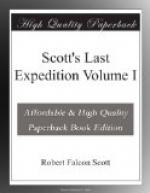The massive type formed by very fluid lavas—Mauna Loa (Hawaii), Vesuvius, examples.
The more perfect cones formed by ash talus—Fujiama, Discovery.
The explosive type with parasitic cones—Erebus, Morning, Etna.
Fissure eruption—historic only in Iceland, but best prehistoric examples Deccan (India) and Oregon (U.S.).
There is small ground for supposing relation between adjacent volcanoes—activity in one is rarely accompanied by activity in the other. It seems most likely that vent tubes are entirely separate.
Products of volcanoes.—The lecturer mentioned the escape of quantities of free hydrogen—there was some discussion on this point afterwards; that water is broken up is easily understood, but what becomes of the oxygen? Simpson suggests the presence of much oxidizable material.
CO_2 as a noxious gas also mentioned and discussed—causes mythical ‘upas’ tree—sulphurous fumes attend final stages.
Practically little or no heat escapes through sides of a volcano.
There was argument over physical conditions influencing explosions—especially as to barometric influence. There was a good deal of disjointed information on lavas, ropy or rapid flowing and viscous—also on spatter cones and caverns.
In all cases lavas cool slowly—heat has been found close to the surface after 87 years. On Etna there is lava over ice. The lecturer finally reviewed the volcanicity of our own neighbourhood. He described various vents of Erebus, thinks Castle Rock a ’plug’—here some discussion—Observation Hill part of old volcano, nothing in common with Crater Hill. Inaccessible Island seems to have no connection with Erebus.
Finally we had a few words on the origin of volcanicity and afterwards some discussion on an old point—the relation to the sea. Why are volcanoes close to sea? Debenham thinks not cause and effect, but two effects resulting from same cause.
Great argument as to whether effect of barometric changes on Erebus vapour can be observed. Not much was said about the theory of volcanoes, but Debenham touched on American theories—the melting out from internal magma.
There was nothing much to catch hold of throughout, but discussion of such a subject sorts one’s ideas.
Saturday, June 17.—Northerly wind, temperature changeable, dropping to -16 deg..
Wind doubtful in the afternoon. Moon still obscured—it is very trying. Feeling dull in spirit to-day.
Sunday, June 18.—Another blizzard—the weather is distressing. It ought to settle down soon, but unfortunately the moon is passing.
Held the usual Morning Service. Hymns not quite successful to-day.
To-night Atkinson has taken the usual monthly measurement. I don’t think there has been much change.
Monday, June 19.—A pleasant change to find the air calm and the sky clear—temperature down to -28 deg.. At 1.30 the moon vanished behind the western mountains, after which, in spite of the clear sky, it was very dark on the floe. Went out on ski across the bay, then round about the cape, and so home, facing a keen northerly wind on return.




